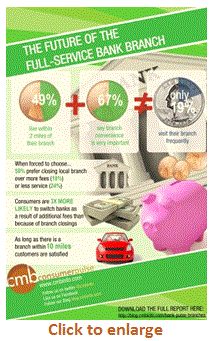 Thirty years ago, the ATM revolutionized banking convenience by letting customers conduct their business at any time, and without stepping foot in a branch— there are now several generations who can’t remember a time before you could just “hit the machine.” But all that automation meant fewer bank customers face to face with bank reps and the products they sell. Decades later, rising cost pressures, new regulations, consumer desire for added convenience, and diminishing returns on full-service bank branches have created an economic challenge for banks.
Thirty years ago, the ATM revolutionized banking convenience by letting customers conduct their business at any time, and without stepping foot in a branch— there are now several generations who can’t remember a time before you could just “hit the machine.” But all that automation meant fewer bank customers face to face with bank reps and the products they sell. Decades later, rising cost pressures, new regulations, consumer desire for added convenience, and diminishing returns on full-service bank branches have created an economic challenge for banks.
To understand the impact of these changes, through our Consumer Pulse we explored customer perspectives on bank convenience, fees, and branch alternatives. We found what bank customers say they value, doesn’t necessarily match up with what they’re actually doing. We asked people how important having a branch nearby was to their sense of banking convenience—most (67%) reported it was “very important.” Taken by itself this isn’t a shocking statistic; we know bank customers appreciate personal service and convenience. But asked how often they actually go to a bank (not an ATM—a full-service branch) nearly half (45%) go fewer than 5 times per year.
What explains this disconnect between what consumers say they need and what they actually use? Online and mobile banking services mean customers can conduct most transactions from the comfort of their home or office. Although a trip to the local branch is often unnecessary when you can check your balance, transfer funds, or make payments from your phone, customers find full-service branches appealing. Still, fond memories may not be enough to keep branches, as customers know them, open.
For the first time in over a decade, banks are closing branches faster than they’re opening them, and banks are looking to alternatives with lower overhead and operating costs. To understand what alternatives were most and least appealing, we asked respondents to participate in a trade-off exercise to evaluate new banking concepts. When forced to choose, customers were willing to give up their local branches rather than see fees rise. These findings suggest branch proximity, while still important to many, is not as critical to a convenient banking experience as it might have been in the past.
One of the alternative banking concepts we tested was the” teller-less” branch. The teller-less branch is largely automated, but sales professionals are available to discuss bank products, and customer representatives are available by phone. In one of the more surprising findings, customers said they would rather have their local branch close altogether than have it replaced with a teller-less branch. This finding, while counter-intuitive, is telling—banks will need to educate their customers on how new banking concepts will affect and benefit them.
While the full-service bank branch may become a thing of the past, banking convenience and service are as relevant to today’s bank customers as ever—even as the modes of service change.
![]() Download the full report: The Future of the full-Service bank Branch here.
Download the full report: The Future of the full-Service bank Branch here.
Posted by Jim Garrity, Jim is Managing Director of CMB’s Financial Services practice. He hasn’t stepped foot in his bank branch in months.

